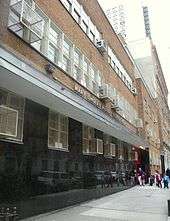Mary Lindley Murray
Mary Lindley Murray is known in American Revolutionary folklore as the Quaker woman who held up British General William Howe after the British victory against American forces at Kips Bay. According to legend, Murray treated Howe and his generals to cake and wine and delayed them several hours as the American rebels got away safely and undetected.

Though legend portrays her as tempting the British with her charms, David McCullough notes in his book 1776 that "she may have been extremely charming, but she was also a woman in her fifties and the mother of twelve children."[1]
MARY MURRAY
The important service rendered to the American cause by Mrs. Murray, who saved Gen. Putnam and his troops from a surprise by the British, has been mentioned.* One of her descendants has communicated a few additional particulars concerning her. Her maiden name was Mary Lindley, and she was of a Quaker family. She was born in Pennsylvania, and resided in that colony for some years after her marriage to Robert Murray. Her eldest son, Lindley—so extensively known for his work on the grammar of the English language—was born at the town of Swatara, near Lancaster. In 1753 she removed with her family to the city of New York, where Murray became ere long one of the wealthiest and most respected merchants. He had joined the society of Friends from a persuasion of the truth of their creed and approbation of their customs, and though he was one of the four or five gentlemen who first rode in their coaches, he had a dislike to everything like luxury or ostentation, always terming his carriage his ' leather convenience.' Mrs. Murray is remembered in the family tradition as * See Vol. II., p. 294.
a person of great dignity and stateliness of deportment. Her disposition is described by a tribute to her memory in the memoirs of her son, Lindley Murray : " My mother was a woman of amiable disposition, and remarkable for mildness, humanity and liberality of sentiment. She was indeed a faithful and affectionate wife, a tender mother, and a kind mistress. I recollect with emotions of affection and gratitude her unwearied solicitude for my health and happiness."
About the year 1764 Mr. Murray removed his family to England and remained there, on account of his health, till 1775. He was descended of a noble Scottish family, whose younger branches, like many other scions of nobility, had found themselves obliged, in impoverished and troublous times, to seek their fortune in the new world. It was natural, therefore, that he should retain their prejudices, and he continued disposed to loyalism during his life, while his wife, as the anecdote recorded of her testifies, joined with all her sympathies in the contest for liberty in her native land. The scene of her detention of the British officers was ' The Grange,' a small country seat at Murray Hill, some time since removed to make way for the improvements of the growing city.
Mrs. Murray died December 25, 1782, (0. S.) Many of her descendants are now living in New York : those of her son, John Murray, and her daughters, Beulah— Mrs. Martin Hoffman—and Susannah—the wife of a British officer—Col. Gilbert Colden Willett, a grandson of the English Lieutenant-Governor Colden. [2]
She also has descendants living in Kansas City named Lincoln and Jessi Murray.